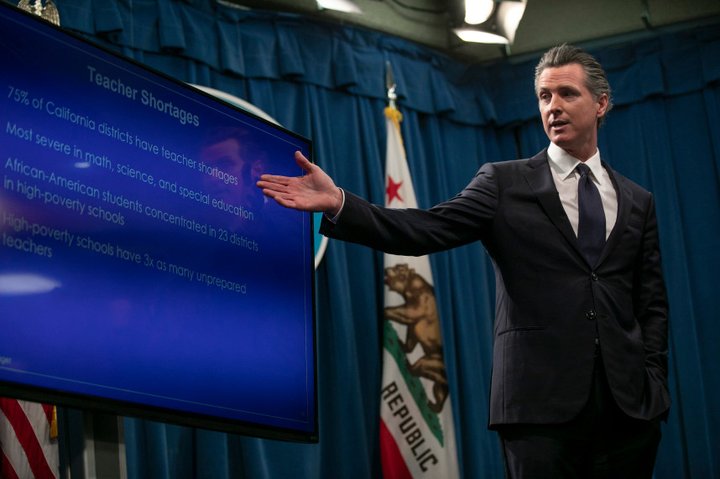
In this file photo, Gov. Gavin Newsom presents the 2020-21 state budget at a press conference at the California Capitol on Jan. 10, 2020. Photo by Anne Wernikoff for CalMatters
###
California finance officials just revealed a $54.3 billion deficit in the first economic assessment of the coronavirus pandemic’s devastating blow to the fifth-largest economy in the world.
That figure is higher than the deficit during the Great Recession and obliterates the state’s once-healthy reserves.
Without sugar-coating how hard the prolonged shutdown of businesses and job losses will hit the state, Gov. Gavin Newsom’s administration released bleak projections on key statewide indicators: 18% unemployment rate for the year, 21% drop in new housing permits and nearly 9% decline in California personal income.
All this signals a financial tsunami and cuts to schools, health care and safety-net programs, as state and local governments turn to the federal government for additional stimulus support. In one example, California’s public school system, including K-12 and community colleges, will lose $18.3 billion, setting back years of striving to reach adequate education funding.
During his daily press briefing Wednesday, the governor signaled that the budget figures would be “jaw-dropping” and sought to brace the public for a prolonged recovery. Newsom said Wednesday that the budget can’t be balanced without significant help from Washington, D.C.
Newsom also announced tax reprives for homeowners and businesses if they suffered financial hardship from the pandemic.
The governor’s budget update projects California’s economic losses will fall disproportionately hard on low- and middle-income Californians, which will only exacerbate income inequality. At the same time, low-income households and people of color are at greater risk of contracting and dying from the virus as the number of confirmed cases reaches 60,000.
Since mid-March, Californians have filed more than 4.2 million unemployment claims.
“This is particularly concerning because the average income did not return to pre-Great Recession levels until 2018,” wrote the Department of Finance in its fiscal update today.
It’s an about-face for a state that began the year with ambitions of expanding child care for working parents and health care for undocumented seniors. Compared to the budget Newsom released in January, the state’s three main revenue sources in the general fund are now projecting a 25.5% drop in personal income taxes, 27.2% drop in sales taxes and 22.7% drop in corporate taxes
The $54.3 billion deficit is driven by three factors: $41.2 billion in revenue loss, $7.1 billion increase in health and human services programs, mainly Medi-Cal, the state’s health program for the poor, and about $6 billion in additional spending, mainly driven by the state’s response to COVID-19. The Newsom administration’s response has come under scrutiny as lawmakers demand oversight of multi-million dollar contracts and federal investigators look into supply deals gone awry.
A full budget revision will be released May 14.
###
CALmatters.org is a nonprofit, nonpartisan media venture explaining California policies and politics.
CLICK TO MANAGE